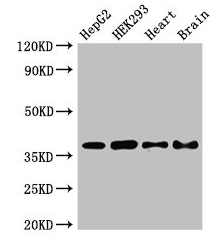Full Product Name
Rabbit anti-Homo sapiens (Human) PNKD Polyclonal antibody
Alternative Names
2210013N15Rik antibody; 2810403H05Rik antibody; AI854243 antibody; BRAIN PROTEIN 17 antibody; BRP17 antibody; DYT8 antibody; FKSG19 antibody; FPD1 antibody; KIAA1184 antibody; KIPP1184 antibody; MNCb-5687 antibody; MR-1 antibody; MR1 antibody; Myofibrillogenesis regulator 1 antibody; Paroxysmal nonkinesiogenic dyskinesia protein antibody; PDC antibody; PKND1 antibody; Pnkd antibody; PNKD_HUMAN antibody; Probable hydrolase PNKD antibody; TAHCCP2 antibody; Trans-activated by hepatitis C virus core protein 2 antibody
Species Reactivity
Human, Mouse
Immunogen
Recombinant Human Probable hydrolase PNKD protein (78-243AA)
Immunogen Species
Homo sapiens (Human)
Conjugate
Non-conjugated
The PNKD Antibody (Product code: CSB-PA843154LA01HU) is Non-conjugated. For PNKD Antibody with conjugates, please check the following table.
Available Conjugates
| Conjugate |
Product Code |
Product Name |
Application |
| HRP |
CSB-PA843154LB01HU |
PNKD Antibody, HRP conjugated |
ELISA |
| FITC |
CSB-PA843154LC01HU |
PNKD Antibody, FITC conjugated |
|
| Biotin |
CSB-PA843154LD01HU |
PNKD Antibody, Biotin conjugated |
ELISA |
Purification Method
>95%, Protein G purified
Concentration
It differs from different batches. Please contact us to confirm it.
Buffer
Preservative: 0.03% Proclin 300
Constituents: 50% Glycerol, 0.01M PBS, PH 7.4
Tested Applications
ELISA, WB
Recommended Dilution
| Application |
Recommended Dilution |
| WB |
1:500-1:5000 |
Storage
Upon receipt, store at -20°C or -80°C. Avoid repeated freeze.
Lead Time
Basically, we can dispatch the products out in 1-3 working days after receiving your orders. Delivery time maybe differs from different purchasing way or location, please kindly consult your local distributors for specific delivery time.
Usage
For Research Use Only. Not for use in diagnostic or therapeutic procedures.







